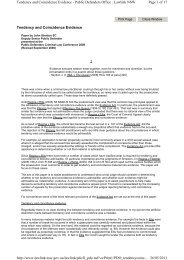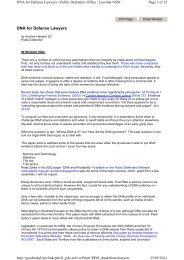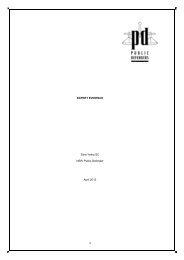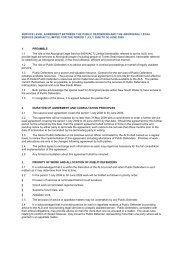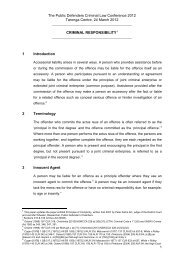Right to Silence: inferences from silence - The Public Defenders
Right to Silence: inferences from silence - The Public Defenders
Right to Silence: inferences from silence - The Public Defenders
Create successful ePaper yourself
Turn your PDF publications into a flip-book with our unique Google optimized e-Paper software.
questions intended <strong>to</strong> probe or test the prosecution case. <strong>The</strong> effect of specific and<br />
positive suggestions <strong>from</strong> counsel, whether or not accepted, is <strong>to</strong> plant in the jury’s mind the<br />
accused’s version of events. This may be so even if the witness rejects the suggestion, since<br />
the jury may mistrust the witness’s evidence.<br />
If the judge is in doubt whether counsel is merely testing the prosecution case or<br />
putting a positive case, counsel should be asked, in the absence of the jury, <strong>to</strong> make<br />
the position clear.<br />
However, the positive case ought <strong>to</strong> be apparent <strong>from</strong> the Defence Statement made in<br />
advance of trial.<br />
<strong>The</strong> same reasoning also led the House of Lords <strong>to</strong> conclude that the adoption by counsel<br />
of evidence given by a co-defendant may amount <strong>to</strong> reliance on the relevant facts or<br />
matters.<br />
Following Webber it has been held that the putting forward by an accused of a possible<br />
explanation for his fingerprints being on a car number plate is a ‘fact’ as broadly construed<br />
in that case (Esimu (2007) 171 JP 452).<br />
In Betts [2001] 2 Cr App R 257, a bare admission at trial of a part of the prosecution case<br />
was held incapable of constituting a ‘fact’ for the purposes of s. 34. <strong>The</strong> alternative<br />
construction would effectively have removed the accused’s right <strong>to</strong> <strong>silence</strong> by requiring him<br />
<strong>to</strong> make admissions at interview, an obligation which would have conflicted with the ECHR,<br />
Article 6.<br />
If the prosecution fail <strong>to</strong> establish that the accused has failed <strong>to</strong> mention a fact, the jury<br />
should be directed <strong>to</strong> draw no inference (B (MT) [2000] Crim LR 181).<br />
Where the judge directs the jury on the basis that s. 34 applies, it is important that the<br />
facts relied on should be identified in the course of the direction (Lewis [2003] EWCA<br />
Crim 223; Lowe [2007] EWCA Crim 833, in which the judge was allowed some latitude in a<br />
complex case in not having <strong>to</strong> list every fact, as distinct <strong>from</strong> the parts of the case, which<br />
were not disclosed).<br />
<strong>The</strong> identification of the specific fact or facts is required by the Judicial Studies Board<br />
Direction, which also suggests that any proposed direction should be discussed with<br />
counsel before closing speeches.<br />
In B the Court of Appeal stated:<br />
“In our view it is particularly important that judges should take this course<br />
in relation <strong>to</strong> directions as <strong>to</strong> the application of section 34. That section is a<br />
no<strong>to</strong>rious minefield. Discussion with counsel will reduce the risk of<br />
mistakes.”<br />
Where the prosecution is able <strong>to</strong> identify a specific fact or fact relied upon within the meaning<br />
of s. 34, it does not necessarily follow that the point should be taken at trial: prosecu<strong>to</strong>rs<br />
should remember that the twin mischiefs at which the section is aimed are the positive<br />
defence following a ‘no comment’ interview and the ‘ambush’ defence. Consideration should<br />
therefore be given in other cases <strong>to</strong> whether the withholding of the fact is sufficient <strong>to</strong> justify<br />
the sanction of s. 34, given the weight juries are likely <strong>to</strong> give <strong>to</strong> being directed as <strong>to</strong> adverse<br />
<strong>inferences</strong> (Brizzalari [2004] EWCA Crim 310).<br />
Colin Wells July 2013 Page 8



